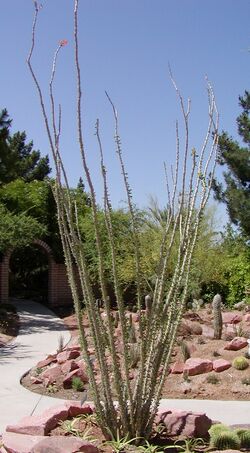Biology:Fouquieria
| Fouquieria | |
|---|---|

| |
| Ocotillo (Fouquieria splendens) | |
| Scientific classification Error creating thumbnail: Unable to save thumbnail to destination
| |
| Kingdom: | Plantae |
| Clade: | Tracheophytes |
| Clade: | Angiosperms |
| Clade: | Eudicots |
| Clade: | Asterids |
| Order: | Ericales |
| Family: | Fouquieriaceae DC.[2] |
| Genus: | Fouquieria Kunth[1] |
| Species | |
|
See text | |
| Synonyms | |
|
Bronnia Kunth | |
Fouquieria is a genus of 11 species of desert plants, the sole genus in the family Fouquieriaceae. The genus includes the ocotillo (F. splendens) and the Boojum tree or cirio (F. columnaris). They have semisucculent stems with thinner spikes projecting from them, with leaves on the bases spikes. They are unrelated to cacti and do not look much like them; their stems are proportionately thinner than cactus stems and their leaves are larger.
Taxonomy
Taxonomic history
Fouquieria species do not have a particularly close resemblance to any other sort of plants; genetic evidence has shown they belong in the Ericales. Before this, they had been variously placed in the Violales or their own order, Fouquieriales.[citation needed]
The Seri people identify three species of Fouquieria in their area of Mexico: jomjéeziz or xomjéeziz (F. splendens), jomjéeziz caacöl (F. diguetii, Baja California tree ocotillo), and cototaj (F. columnaris, boojum).[3]
Etymology
The genus is named after French physician Pierre Fouquier (1776-1850).
Ecology
Fouquieria shrevei is endemic to the Cuatro Ciénegas Basin in Mexico, and is unusual in possessing vertical resinous wax bands on the stems, and exhibits gypsophily, the ability to grow on soils with a high concentration of gypsum. It has aromatic white flowers and is presumed to be moth-pollinated. Other species in the genus with orange or red flowers are pollinated by hummingbirds or carpenter bees. Fouquieria diguetii is host to a peacock mite, Tuckerella eloisae.[citation needed]
The spines of Fouquieria develop in an unusual way, from a woody thickening on the outer (lower) side of the leaf petiole, which remains after the leaf blade and most of the petiole separate and fall from the plant.[4]
Distribution and habitat
These plants are native to northern Mexico and the bordering United States states of Arizona, southern California , New Mexico, and parts of southwestern Texas , favoring low, arid hillsides.[citation needed]
Species
|
|
References
- ↑ 1.0 1.1 "Genus: Fouquieria Kunth". Germplasm Resources Information Network: Fouquieria. 1996-09-17. http://www.ars-grin.gov/cgi-bin/npgs/html/genus.pl?4742.
- ↑ Angiosperm Phylogeny Group (2009). "An update of the Angiosperm Phylogeny Group classification for the orders and families of flowering plants: APG III". Botanical Journal of the Linnean Society 161 (2): 105–121. doi:10.1111/j.1095-8339.2009.00996.x.
- ↑ Felger, Richard S.; Mary B. Moser (1985). People of the Desert and Sea: Ethnobotany of the Seri Indians. Tucson: University of Arizona Press. ISBN 978-0-8165-0818-1. https://archive.org/details/peopleofdesertse0000felg.
- ↑ W. J. Robinson, 1904. The spines of Fouquieria. Bulletin of the Torrey Botanical Club. 31(1):45–50
- ↑ 5.0 5.1 5.2 Rebman, J. P.; Gibson, J.; Rich, K. (2016). "Annotated checklist of the vascular plants of Baja California, Mexico". San Diego Society of Natural History 45: 174. http://sdplantatlas.org/pdffiles/BajaChecklist2016.pdf.
- ↑ "Species Records of Fouquieria". Germplasm Resources Information Network: Fouquieria. http://www.ars-grin.gov/cgi-bin/npgs/html/splist.pl?4742GRIN.
- Moser, Mary B.; Stephen A. Marlett (2005) (in es, en). Comcáac quih yaza quih hant ihíip hac: Diccionario seri-español-inglés. Hermosillo, Sonora: Universidad de Sonora and Plaza y Valdés Editores. http://lengamer.org/admin/language_folders/seri/user_uploaded_files/links/File/DiccionarioSeri2005.pdf.
External links
- The Fouquieria Page at the National University of Mexico with photos of the species in the wild
- Fouquieriaceae in L. Watson and M.J. Dallwitz (1992 onwards). The families of flowering plants.
Wikidata ☰ Q133229 entry
 |

